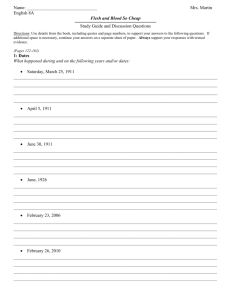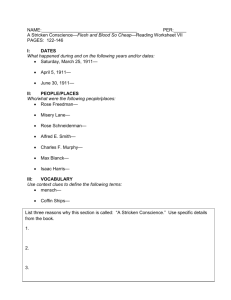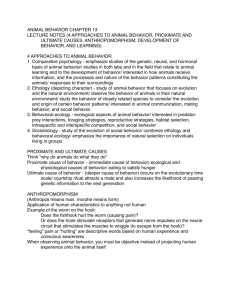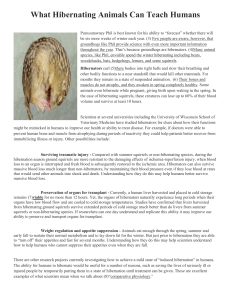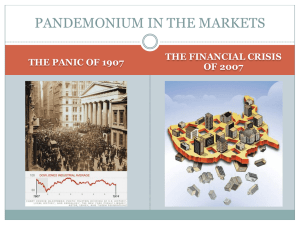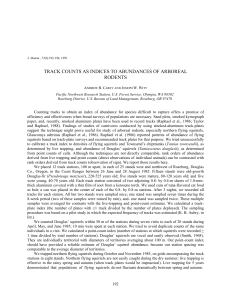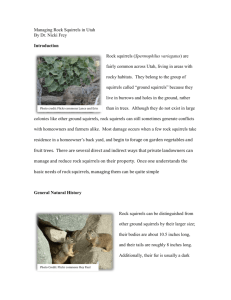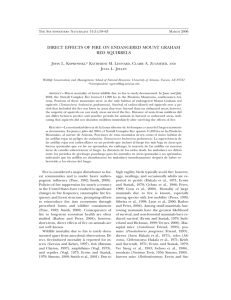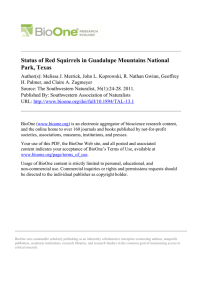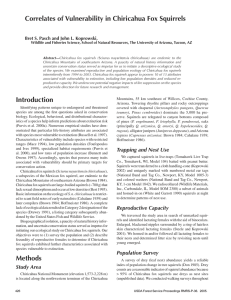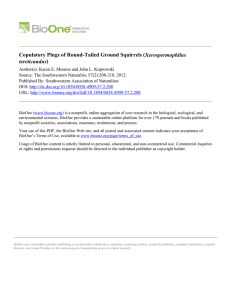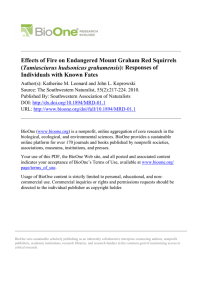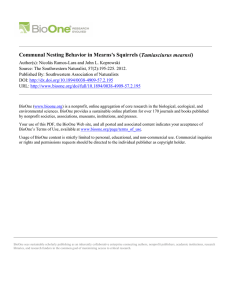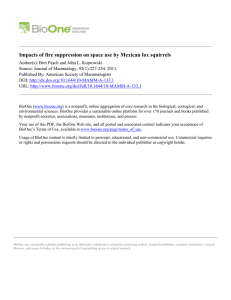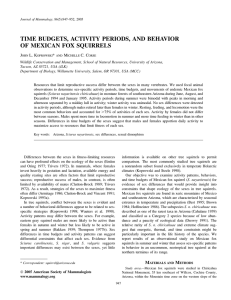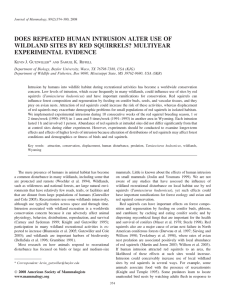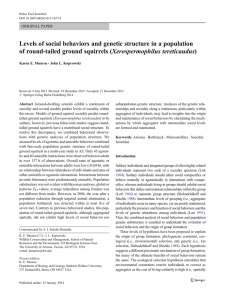Population Growth
advertisement
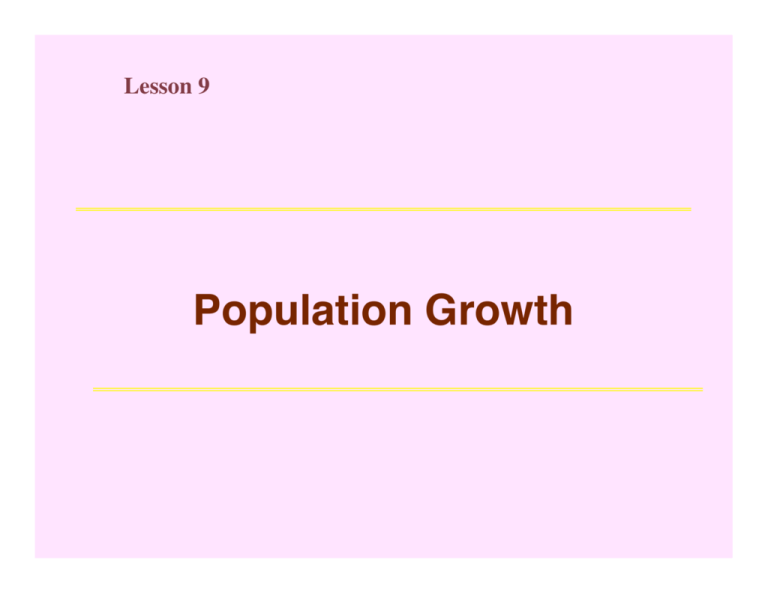
Lesson 9 Population Growth Last time Inclass Group Work 1- What is the average value of f(x) = 7 on the interval [2, 6]? b 6 1 1 f (x)dx = 7 dx " " b!a a 6!2 2 1 !!!!!!!!!!!!!!!!!!!!!!!!!= (7 # 4) = 7 4 10 5 -20 -10 10 -5 -10 20 Last time Inclass Group Work 2- Suppose the following integrals are known : ! b a f (x) dx = 4 ! ( f (x)) b a 2 dx = 5 ! b a g(x) dx = "2 ! ( g(x)) b a 2 dx = 7 Find the integrals a •" f ( x ) g ( x )dx =0 a • " a b ! f ( x ) + 3 g ( x )dx =10 b • " f ( x ) ! 3 g ( x )dx =10 a • " ( f ( x ) ) dx ! 2 (" b a 2 b a ) 2 g ( x ) dx =-3 Absolute Growth Today: Several different ways to model the growth of populations. Let P(t) be the population at time t. The absolute growth rate is the rate of change of P, or P'(t). Aproximate with average absolute growth rate from t = a to t = b: Much like finding average velocity Example 19 squirrels in 1998 27 squirrels in 2000 What is the absolute growth rate? 27 ! 19 8 = = 4!squirrels!/!year 2000 ! 1998 2 on average, the squirrel population went up about 4 squirrels per year in this time period. Constant Absolute Growth To model constant absolute growth, use P(t) = A + B t Where: A is the initial population B is the absolute growth rate Example We start an exclusive club with 70 members, and recruit 7 new members per week. After t weeks, we have P(t) = 70 + 7t Note: P(0) = 70 members. P(1) = 77 P(2) = 84, etc. Change in Population? Given the absolute growth rate P'(t), it is trivial(using FTC) to find the change in population from t = a to t = b: Relative Growth Rate Growth as a percentage of current population, so relative growth rate is P'(t)/P(t). Average relative growth rate: Average absolute growth rate Initial population Often used to describe natural populations. Example 19 squirrels in 1998 27 squirrels in 2000 What is the relative growth rate? 27 ! 19 8 = " 0.21 (2000 ! 1998)(19) 38 Or about 21% per year. Constant Relative Growth Start with population A, and have relative growth rate r. How can we model this? Original population P(1) = A + Ar = A(1 + r) Change in population P(2) = A(1 + r) + [A(1 + r)]r = [A(1 + r)](1 + r) = A(1 + r)2 Original population Change in population The pattern repeats… after t years we have P(t) = A(1 + r)t Like multiplying by “100 and r” percent each time Example Population starts at 1.7 million in 1970, and increases by 2% each year. Note the 102% here! After t years, population is P(t) = 1.7(1 + .02)t = 1.7(1.02)t million. Check: P(1) = 1.7(1.02) = 1.734 million. Relative change: Change in Population For absolute growth, it is easy to get from growth rate P'(t) to total absolute growth: But the relative growth rate is ! What can we get from this? Question Find the derivative: So the relative rate of growth is the derivative of ln(P(t))! Relative Change So by the fundamental theorem, This would be the percentage change in the population! To get P(b)/P(a) out, we will have to raise e to the power of the integral’s result. Relative Change To find relative change from a relative rate of change: (1) Integrate the relative rate of change (2) Raise e to the power of the result. (3) You now have P(b)/P(a). Example Estimate the relative change in the population from 1907 to 1911. Step 1: Integrate Year 1907 Relative Growth Rate 0.01 1909 1911 0.005 0.021 This is ln(P(1911)/P(1907)) Step 2: Raise e to 0.034 So P(1911) is about 103.5% of P(1907). P(1911)/P(1907) Or: The population increased by about 3.5%. Average vs. Instantaneous Two ways to view “increase by 2% per year”: • Instantaneous rate of 2% per year - This leads to y' = 0.02 y, and y = Ce0.02t. • By the end of each year, we have increased by 2%. - This leads to A(1.02)t. Note that: If y = Ae.02t, y(1) = Ae.02, or about 1.020201A. If y = A(1.02)t, then y(1) = 1.02A. Summary " P ( b) ! P ( a ) # $ % b!a & ' " P(b) ! P(a) % $$ '' # (b ! a)P(a) & growth rates. and relative • Average absolute •Formulas for a population at time t if the population has a constant absolute ( P(t) = A + Bt ) or relative ( P(t) = A(1+ r) ) growth rate. t •Found the relative change in the population based on its relative growth rate, by integrating the relative growth rate to find ln(P(b)/P(a)), and then solving for P(b)/P(a). •Discussed the difference between constant instantaneous and constant average relative growth. In-class Group Work Relative growth rate given by the graph. Find the relative change in the population from year 0 to 15. Hint: Use what we know about the relationship between area and the integral. In-class Group Work Relative growth rate given by the graph. Find the relative change in the population from year 0 to 15. 15 P '( t ) P(15) "0 P ( t ) dt =e = e0.1!0.025 = e0.075 # 1.078 P(0) So P(15) is about 107.8% of P(0). Or: The population increased by about 7.8%.


